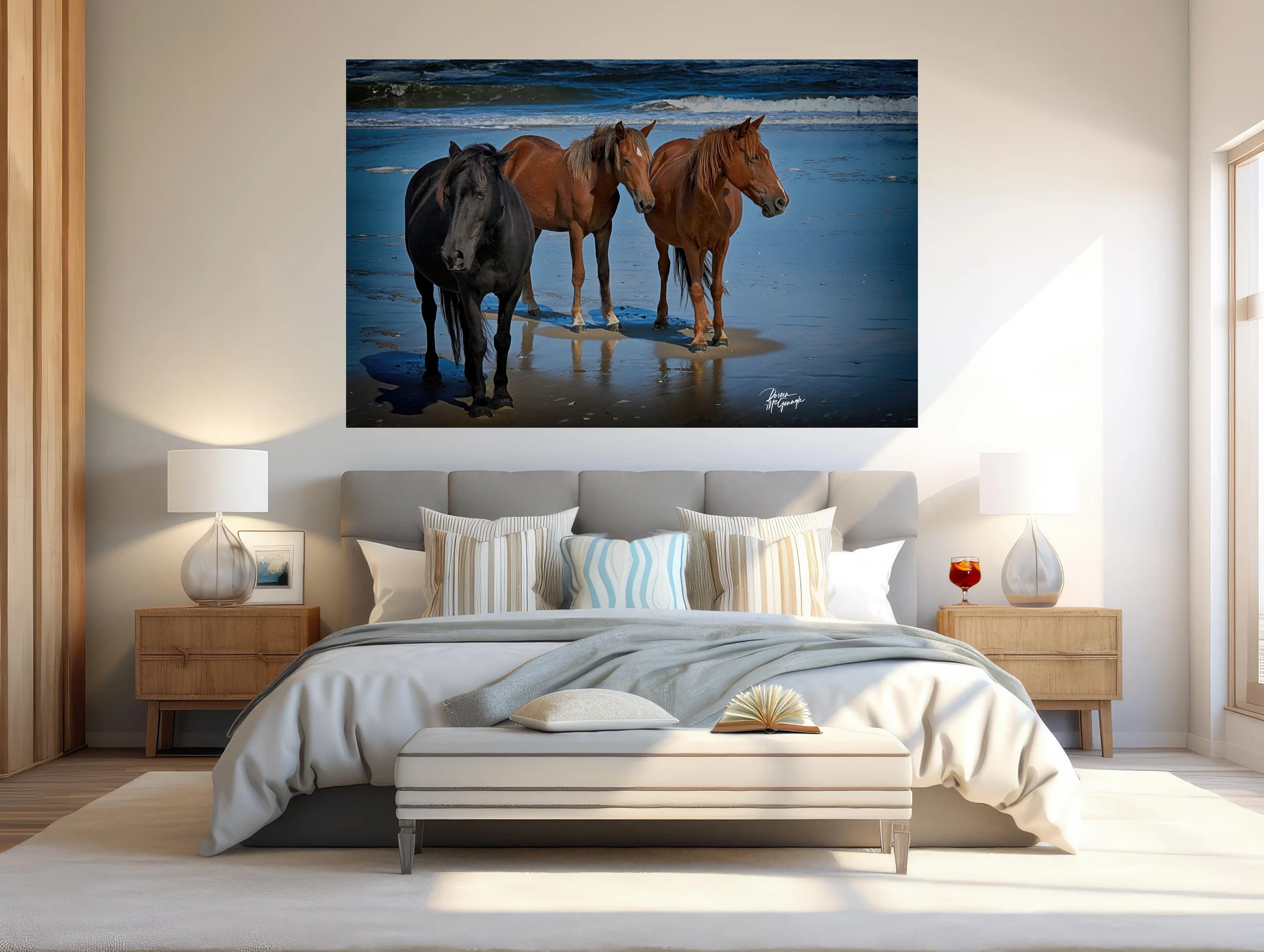Tips for Photographing Wild Horses: A Guide to Outer Banks Wildlife
Wild horses roam freely along the shores of North Carolina’s Outer Banks, making it one of the most magical places for wildlife photography. Capturing the beauty of these majestic creatures in their natural habitat is both challenging and rewarding. Having spent time behind the lens in the Outer Banks, particularly in Corolla where the wild horse herds are most active, I’ve gathered some essential tips for fellow photographers and art collectors who wish to embark on this incredible journey. with me.
1. Do Your Research
Before setting out, it’s important to understand the habits of wild horses. Wild horses of the Outer Banks, such as the Corolla Wild Horses, are known to roam across the dunes, beaches, and marshlands. These feral horses are descendants of Spanish mustangs, and they thrive in small family groups. Knowing where and when to look is key to maximizing your chances of a good shot.
2. Use a Telephoto Lens
To photograph wild horses without disturbing them, a telephoto lens is essential. These horses are protected, and there are strict regulations to maintain a safe distance of at least 50 feet. A lens of at least 200mm will help you capture detailed shots while respecting their space. In my experience, longer lenses (300mm-400mm) offer the best opportunities for capturing close-ups of wild horses while ensuring their safety and comfort.
3. Timing is Everything
Early mornings and late afternoons provide the best light for wildlife photography. Known as the "golden hours," the soft, diffused light during these times can add a beautiful warmth to your images. In the Outer Banks, the wild horses often roam the beaches at dawn or dusk, making these the prime hours for capturing stunning shots of them against the backdrop of the rising or setting sun. The reflections on the wet sand or the vibrant colors of the sky create dramatic effects in photos.
4. Be Patient and Observant
Photographing wild horses requires patience. Spend time observing their behavior and movements before snapping away. You might capture moments of interaction within the herd, foals playing, or even horses galloping along the shoreline. These candid moments are worth the wait and often result in the most powerful images. On one of my trips, I spent nearly an hour simply watching the horses from a distance before the perfect opportunity to photograph a playful foal appeared.
5. Capture the Landscape
The natural beauty of the Outer Banks should not be overlooked. Incorporating the surrounding landscape into your photos can elevate your wild horse photography. Dunes, grasses, and the ocean provide a dynamic and textured background, enhancing the overall composition. If you’re lucky enough to photograph them near the shoreline, you can capture the horses with crashing waves behind them, adding an element of movement and energy to the scene.
Equine Solitude
Equine Solitude by the Sea is a captivating fine art photography print that embodies the tranquility and connection between nature and wildlife.
OBX 5667-09 c2024 | North Carolina | Learn more
6. Focus on the Eyes
In wildlife photography, especially with wild horses, the eyes tell a story. Focusing on the horse’s eyes brings emotion to the photograph and engages the viewer. Whether it’s a wide-eyed foal or the soulful gaze of a mature stallion, the eyes are what often make an image unforgettable.
Equine Reflection
Equine Reflections on the Shore not only celebrates the beauty of wildlife photography but also emphasizes the striking harmony between the horses and their coastal surroundings.
OBX 5726-12 c2024 | North Carolina | Learn More
7. Keep Your Distance and Respect the Horses
One of the most important tips for any wildlife photographer is to respect your subject. The wild horses of the Outer Banks are protected by law, and interfering with their natural behavior is not only harmful but also illegal. Use your zoom to get close, but always keep your distance. Avoid any sudden movements or loud noises that may startle them. A calm and quiet approach will yield better results and allow you to photograph the horses as they go about their lives naturally.
8. Prepare for the Elements
The weather on the Outer Banks can be unpredictable. Be prepared for changing conditions by packing appropriate gear, such as rain covers for your camera and a sturdy tripod for windy days. Sand can also be an issue, so bring cleaning kits to keep your lenses free of dust and debris. During one of my shoots, sudden rain turned into a perfect photo opportunity, casting a dramatic, moody light over the dunes as the horses calmly weathered the storm.
Conclusion
Photographing wild horses in the Outer Banks is an unforgettable experience. Whether you're aiming for candid moments of herd interaction or a stunning silhouette against a sunset, patience, preparation, and respect for these magnificent animals are key. For those who may not be able to experience this firsthand, I invite you to explore my Fine Art Photography Gallery. My limited edition prints of wild horses from the Outer Banks capture their untamed beauty and the spirit of freedom they embody. Available in large wall art sizes and printed on high-quality Acrylic and Canvas Pro, each piece is a true investment in fine art, perfect for transforming your home into a tribute to the wild.
Browse the collection today and bring the elegance of these majestic creatures into your home or office space.


